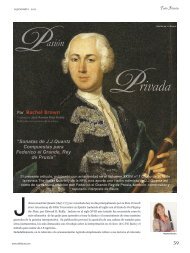Telemann Fantasias article + music - Rachel Brown
Telemann Fantasias article + music - Rachel Brown
Telemann Fantasias article + music - Rachel Brown
You also want an ePaper? Increase the reach of your titles
YUMPU automatically turns print PDFs into web optimized ePapers that Google loves.
Each fantasia is complete in itself but the collection together creates a monumental<br />
whole. <strong>Telemann</strong> set each fantasia in a different tonality, ascending from A major<br />
through A minor, B minor, Bb major, C major, D minor, D major, E minor, E major,<br />
F# minor and G major to G minor. This cyclic, almost encyclopaedic presentation was<br />
a popular mode of composition at the time; alongside the famous Forty-eight Preludes<br />
and Fugues and the Two- and Three-Part Inventions by J.S. Bach are lesser-known<br />
examples for flute such as Schickhardt’s L’Alphabet de la Musique, twenty-four<br />
sonatas in all major and minor keys, published in London in 1735.<br />
Composers and theorists of the day (such as Rousseau, Charpentier, Mattheson and<br />
Rameau) firmly believed that each tonality could assume its own character and<br />
produce certain Affekts. <strong>Telemann</strong>, who grew up playing the flute, clearly understood<br />
how to play with these powerful elements of Rhetoric. Thus contrasting moods of joy,<br />
brilliance, fun, passion, pride, seriousness, coldness, plaintiveness, serenity,<br />
tenderness, delicacy and charm as well as rustic and courtly dancing are reflected in<br />
not only the choice and juxtaposition of keys but also the chosen register and motives<br />
such as bold arpeggios, characterful rhythms or more lyrical legato lines.<br />
The set opens in A major in a bright and at times playful mood reflecting the<br />
improvisatory nature of this most fragmentary prelude. The more pastoral and pensive<br />
qualities of A major appear in the closing dance, a Passepied. The contrast with A<br />
minor is stark; the opening arpeggios and implied suspensions of sevenths set a<br />
serious, plaintive tone (ex.3).<br />
Grave<br />
"<br />
!<br />
# $ $ $<br />
# "<br />
! '!<br />
$ % $ $ & $ $ $<br />
' !<br />
7<br />
$ $<br />
$ '!<br />
Ex.3 <strong>Telemann</strong> Fantasia in A minor, Largo, bars 1-4<br />
6<br />
$ $ $<br />
$<br />
'<br />
'!<br />
7<br />
% $ $ $ $<br />
$<br />
6<br />
$ $ $<br />
B minor continues in a lonely and melancholic vein yet with elements of the bizarre<br />
such as the hints towards chromatic glissando in the opening gesture (ex.4).<br />
" !<br />
# Largo<br />
#<br />
$ $ $!<br />
$ $ $!<br />
$ $ $ $<br />
# $<br />
$ %<br />
Ex.4 <strong>Telemann</strong> Fantasia in B minor, Largo, bars 1-2<br />
Making a glissando by sliding fingers off the holes was described by Tromlitz in 1791<br />
and became more common in the nineteenth century with players such as Charles<br />
Nicholson. Bb major is an inherently sunnier key which could, by turn, be proud or<br />
delicate, qualities so closely associated with the Polonaise dance of the Allegro. C




